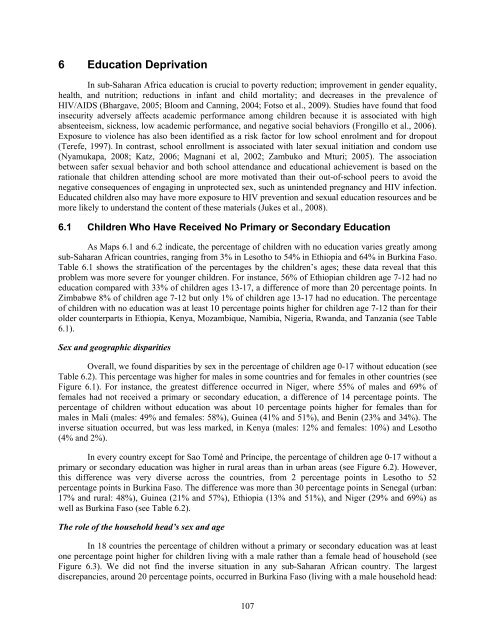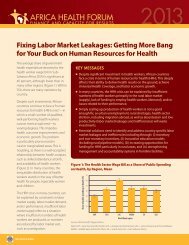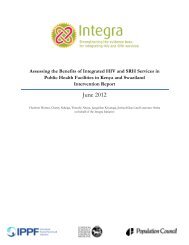ujh78
ujh78
ujh78
Create successful ePaper yourself
Turn your PDF publications into a flip-book with our unique Google optimized e-Paper software.
6 Education Deprivation<br />
In sub-Saharan Africa education is crucial to poverty reduction; improvement in gender equality,<br />
health, and nutrition; reductions in infant and child mortality; and decreases in the prevalence of<br />
HIV/AIDS (Bhargave, 2005; Bloom and Canning, 2004; Fotso et al., 2009). Studies have found that food<br />
insecurity adversely affects academic performance among children because it is associated with high<br />
absenteeism, sickness, low academic performance, and negative social behaviors (Frongillo et al., 2006).<br />
Exposure to violence has also been identified as a risk factor for low school enrolment and for dropout<br />
(Terefe, 1997). In contrast, school enrollment is associated with later sexual initiation and condom use<br />
(Nyamukapa, 2008; Katz, 2006; Magnani et al, 2002; Zambuko and Mturi; 2005). The association<br />
between safer sexual behavior and both school attendance and educational achievement is based on the<br />
rationale that children attending school are more motivated than their out-of-school peers to avoid the<br />
negative consequences of engaging in unprotected sex, such as unintended pregnancy and HIV infection.<br />
Educated children also may have more exposure to HIV prevention and sexual education resources and be<br />
more likely to understand the content of these materials (Jukes et al., 2008).<br />
6.1 Children Who Have Received No Primary or Secondary Education<br />
As Maps 6.1 and 6.2 indicate, the percentage of children with no education varies greatly among<br />
sub-Saharan African countries, ranging from 3% in Lesotho to 54% in Ethiopia and 64% in Burkina Faso.<br />
Table 6.1 shows the stratification of the percentages by the children’s ages; these data reveal that this<br />
problem was more severe for younger children. For instance, 56% of Ethiopian children age 7-12 had no<br />
education compared with 33% of children ages 13-17, a difference of more than 20 percentage points. In<br />
Zimbabwe 8% of children age 7-12 but only 1% of children age 13-17 had no education. The percentage<br />
of children with no education was at least 10 percentage points higher for children age 7-12 than for their<br />
older counterparts in Ethiopia, Kenya, Mozambique, Namibia, Nigeria, Rwanda, and Tanzania (see Table<br />
6.1).<br />
Sex and geographic disparities<br />
Overall, we found disparities by sex in the percentage of children age 0-17 without education (see<br />
Table 6.2). This percentage was higher for males in some countries and for females in other countries (see<br />
Figure 6.1). For instance, the greatest difference occurred in Niger, where 55% of males and 69% of<br />
females had not received a primary or secondary education, a difference of 14 percentage points. The<br />
percentage of children without education was about 10 percentage points higher for females than for<br />
males in Mali (males: 49% and females: 58%), Guinea (41% and 51%), and Benin (23% and 34%). The<br />
inverse situation occurred, but was less marked, in Kenya (males: 12% and females: 10%) and Lesotho<br />
(4% and 2%).<br />
In every country except for Sao Tomé and Príncipe, the percentage of children age 0-17 without a<br />
primary or secondary education was higher in rural areas than in urban areas (see Figure 6.2). However,<br />
this difference was very diverse across the countries, from 2 percentage points in Lesotho to 52<br />
percentage points in Burkina Faso. The difference was more than 30 percentage points in Senegal (urban:<br />
17% and rural: 48%), Guinea (21% and 57%), Ethiopia (13% and 51%), and Niger (29% and 69%) as<br />
well as Burkina Faso (see Table 6.2).<br />
The role of the household head’s sex and age<br />
In 18 countries the percentage of children without a primary or secondary education was at least<br />
one percentage point higher for children living with a male rather than a female head of household (see<br />
Figure 6.3). We did not find the inverse situation in any sub-Saharan African country. The largest<br />
discrepancies, around 20 percentage points, occurred in Burkina Faso (living with a male household head:<br />
107








